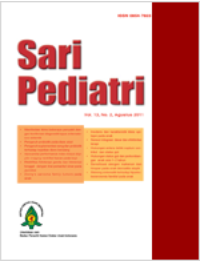Jumlah Eosinofil pada Anak dengan Soil Transmitted Helminthiasis yang Berusia 6-10 Tahun
Sari
Latar belakang. Kecacingan atau soil transmitted helminthes (STH) dan alergi keduanya merupakan masalah kesehatan dengan morbiditas yang cukup luas di berbagai negara. Kecacingan berkaitan dengan peningkatan eosinofil darah yang juga dipengaruhi oleh berbagai faktor termasuk alergi.
Tujuan. Membuktikan jumlah eosinofil darah pada anak usia 6 -10 tahun yang mengalami kecacingan (STH).
Metode. Desain studi observasional menggunakan cross sectional pada anak usia 6–10 tahun yang memenuhi kriteria inklusi. Subjek dipilih secara consecutive sampling di empat sekolah dasar di Semarang yang dipilih dengan purposive sampling. Dilakukan pemeriksaan fisik, tinggi badan, berat badan, mengisi kuisinoner International Study of Asthma and Allergies in Childhood (ISAAC), pemeriksaan mikroskopik feses dan jumlah eosinofil darah. Analisis statistik menggunakan uji Mann Whitney dan Pearson chi square.
Hasil. Di antara 74 anak, didapatkan 25 (33,8%) dengan kecacingan (STH) dan 49 tidak kecacingan (66,2%). Pada anak yang mengalami kecacingan (STH), nilai median eosinofil adalah 437,0 (123-1021) dan pada anak yang tidak kecacingan adalah 228,0 (72-1095) dengan nilai p=0,019. Pada kecacingan STH, nilai rasio prevalensi kejadian eosinofilia adalah 3,189 (p=0,025; 95% CI 1,136-8,954). Nilai median eosinofil anak dengan alergi didapatkan 312,0 (111-799) dan pada anak yang tidak alergi didapatkan 251,0(72-1095) dengan nilai p=0,974.
Kesimpulan. Jumlah eosinofil darah pada anak usia 6-10 tahun yang menderita kecacingan (STH) berbeda secara bermakna dengan anak yang tidak mengalami kecacingan.
Kata Kunci
Teks Lengkap:
PDFReferensi
Weinstock JV, Elliott DE. Helminths and the IBD hygiene hypothesis. Tufts New England Medical Center 2009;15:128-33.
Cooper PJ. Interactions between helminth parasites and allergy. Curr Opin Allergy Clin Immunol 2009;9:29-37.
Lynch NR, Hagel IA, Palenque ME, Prisco MCD, Escudero JE, Corao L, dkk. Relationship between helminthic infection and IgE response in atopic and nonatopic children in a tropical environment. J Allergy Clin Immunol 1998;101:217-21.
Bethony J, Brooker S, Albonico M, Geger SM, Loukas A, Diemert D, dkk. Soil-transmitted helminth infection: ascariasis, trichuriasis, and hookworm. Lancet 2006;367:1521-32.
Pontre EV, Rizzo JA, Cruz AA. Interrelationship among asthma, atopy and helminth infections. J Bras Pneumol 2007;33:335-42.
Helmby H. Helminths and our immune system : friend or foe? Parasitology Intenational 2009;58:121-7.
Moreau E, Chauvin A. Immunity against helminths: interactions with the host and the intercurrent infections. J Biomed Biotech 2010;2010:1-10.
Ustun S, Turgay N, Delibas SB, Ertabaklar H. Interleukin (IL) 5 level and eosinophilia in patients with intestinal parasitic disease. World J Gastroenterol 2004;10:3643-6.
Anthony RM, Rutitzky LI, Urban JF, Stadecker MJ, Gause WC. Protective immune mechanisms in helminth infection. Nat Rev Immunol 2007;7:975-87.
Nutman TB. Evaluation and differential diagnosis of marked, persistent eosinophilia. Immunol Allergy Clin North Am 2007;27:529-49.
Bradley JE, Jackson JA. Immunity, immunoregulation and the ecology of trichuriasis and ascariasis. Parasite Immunol 2004;26:429-41.
Cooper PJ, Chico ME, Sandoval C, Espinel I, Guevara A, Kennedy MW, dkk. Human infection with ascariasis lumbricoides is associated with a polarized cytokine response. J Infect Dis 2000;182:1207-13.
Turner JD, Faulkner H, Kamgno J, Corment F, Snick JV, Else KJ, dkk. Th2 cytokines are associated with reduced worm burdens in human intestinal helminth infection. J Infect Dis 2003;188:1769-75.
King EM, Kim HT, Dang NT, Michael E, Drake L, Needham C, dkk. Imunno-epidemiology of ascaris lumbricoides infection in a high transmission community : antibody responses and theri impact on current and future infection intensity. Parasite Immunol 2005;27:89-96.
Geiger SM, Caldas IR, Glone BEM, Campi-Azevedo AC, Oliveira LMD, Brooker S, dkk. Stage-spesific immune responses in human Necator americanus infection. Parasite Immunol. 2007;29:347-58.
Loukas A, Prociv P. Immune response in hookworm infection. Clin Microbiol Rev 2001;14:689-703.
Pearce N, Ait-Khaled N, Beasly R, Malool J, Keil U, Mitchell E, dkk. Worldwide trends in the prevalence of asthma symptoms : phase III of the tnternational study of asthma and allergies in childhood (ISAAC). Thorax J BMJ 2007;62:758-66.
Cooper PJ, Barrreto ML, Rodrigues LC. Human allergy and geohelminth infection : a review of the literature and a proposed conceptual model to guide the investigation of possible causal associations. Brit Med Bull Ad Acc 2007;4:1-16.
Smits HH, Everts B, Hartgers FC, Yazdanbakhsh M. Chronic helminth infections protect against allergic disease by active regulatory processes. Curr Allergy Asthma Rep 2010;10:3-12.
Morar N, Derm FC, Willis-Owen SAG, Moffatt MF. The genetics of atopic dermatitis. J Allergy Clin Immunol 2006;118:24-34.
LeMasters GK, Wilson K, Leven L, Biagini J, Ryan P, Lockey JE, dkk. High prevalence of aeroallergen sensitization among infants of atopic parents. J Pediatr 2006;194:505-11.
Schulte C, Krebs B, Jelinek T, Nothdurft HD, Sonnenburg Fv, Loscher T. Diagnostic significance of blood eosinophilia in returning travelers. Brief Reports 2002;34:407-11.
Teo CG, Singh M, Ting WC, Ho LC, Ong YW, Seet LC. Evaluation of the common conditions associated with eosinophilia. J Clin Pathol 1985;38:305-8.
Meeusen EN, Balic A. Do eosinophils have role in the killing of helminth parasites? Parasitol Today 2000;16:95-101.
Dombrowicz D, Capron M. Eosinophils, allergy and parasites. Curr Opin Immunol 2001;13:716-20.
Medeiros D, Silva AR, Rizzo JA, Motta ME, Oliveira FHBd, Sarinho ES. Total IgE level in respiratory allergy: study of patients at high risk for helminthic infection. J de Pediatr 2005;82:255-9.
DOI: http://dx.doi.org/10.14238/sp16.2.2014.79-85
Refbacks
- Saat ini tidak ada refbacks.
##submission.copyrightStatement##
##submission.license.cc.by-nc-sa4.footer##
Email: editorial [at] saripediatri.org


Sari Pediatri diterbitkan oleh Badan Penerbit Ikatan Dokter Anak Indonesia
Ciptaan disebarluaskan di bawah Lisensi Creative Commons Atribusi-NonKomersial-BerbagiSerupa 4.0 Internasional.




